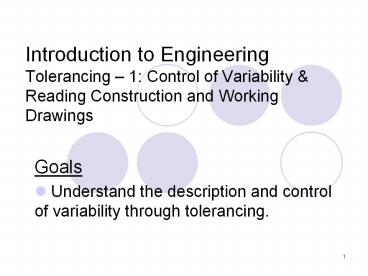Introduction%20to%20Engineering%20Tolerancing%20 - PowerPoint PPT Presentation
Title:
Introduction%20to%20Engineering%20Tolerancing%20
Description:
Introduction to Engineering Tolerancing 1: Control of Variability & Reading Construction and Working Drawings Goals Understand the description and control of ... – PowerPoint PPT presentation
Number of Views:110
Avg rating:3.0/5.0
Title: Introduction%20to%20Engineering%20Tolerancing%20
1
Introduction to EngineeringTolerancing 1
Control of Variability Reading Construction
and Working Drawings
- Goals
- Understand the description and control of
variability through tolerancing.
2
Tolerance is the total amount a dimension may
vary and is the difference between the max. and
min. limits.
- Ways to Express
- Direct limits or as tolerance values applied to a
dimension - Geometric tolerances
- A general tolerance note in title block
- Notes referring to specific conditions
3
Direct limits and tolerance values
4
Geometric Tolerance System
Geometric dimensioning and tolerancing (GDT) is
a method of defining parts based on how they
function, using standard ANSI symbols. (Beyond
our scope for now.)
Feature Control Frame
Concentricity Symbol
5
Tolerance Specifications in Title Block
General tolerance note specifies the following
tolerance for untoleranced dimensions INCHES One
-place decimal ?.1 Two-place decimal
?.02 Three-place decimal ?0.005 MILLIMETERS One-p
lace decimal ?2.5 Two-place decimal
?0.51 Three-place decimal ?0.127
6
Notes referring to specific conditions
General Tolerances could be in the form of a note
similar to the one shown below ALL DECIMAL
DIMENSIONS TO BE HELD TO ?.002 Means that a
dimension such as .500 would be assigned a
tolerance of ?0.002, resulting in a upper limit
of .502 and a lower limit of .498
7
Important Terms
Note Use this figure as a reference for the next
two slides
8
Important Terms single part
- Nominal Size general size, usually expressed in
common fractions (1/2 for the slot) - Basic Size theoretical size used as starting
point (.500 for the slot) - Actual Size measured size of the finished part
(.501 for the slot)
9
Important Terms single part
- Limits maximum and minimum sizes shown by
tolerances (.502 and .498 larger value is the
upper limit and the smaller value is the lower
limit, for the slot) - Tolerance total allowable variance in
dimensions (upper limit lower limit) object
dimension could be as big as the upper limit or
as small as the lower limit or anywhere in
between
10
Important Terms Multiple Parts
- Allowance the minimum clearance or maximum
interference between parts - Fit degree of tightness between two parts
- Clearance Fit tolerance of mating parts always
leave a space - Interference Fit tolerance of mating parts
always interfere - Transition Fit sometimes interfere, sometimes
clear
11
Fitting Two Parts
12
Shaft and Hole Clearance and Interference Fits
Clearance Interference
13
Shaft and Hole Fits Transition Fit
Transition
14
Basic Hole System
- Clearance Hole Shaft
- Cmax Hmax Smin
- Cmin Hmin Smax
- Both Cmax and Cmin gt0 Clearance fit
- Both Cmax and Cmin lt0 Interference fit
- Cmax gt 0 Cmin lt 0 Transition fit
- System Tolerance Cmax - Cmin
15
Basic Hole System Example
Calculate Maximum and Minimum Clearance
Clearance Hole Shaft
Cmax Hmax Smin
Cmax .510 - .485 .025
Cmin
Cmax gt Cmin gt 0 Clearance
What is Type of Fit?
16
Checking your work
- Tolerance of the system the sum tolerances of
all its parts - Check
Tsys Thole Tshaft AND Tsys Cmax - Cmin
Thole Tshaft Cmax - Cmin
17
For Example
- Tsys Thole Tshaft Cmax Cmin
- Thole .510 - .505 .005
- Tshaft .490 - .485 .005
- Cmax Cmin .025 - .015
- Thole Tshaft Cmax Cmin
- .005 .005 .025 - .015
- .010 .010
18
Assignment
- Drawing 7































